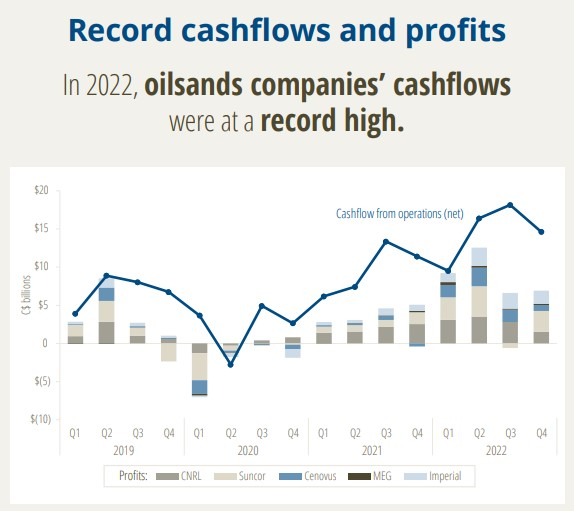Support strong Canadian climate journalism for 2025
Shareholders of Canada’s large oilsands companies took home three times more money last year than in 2019, according to a new analysis, while those same companies asked for more taxpayer money to invest in their climate pledges.
Clean energy think tank the Pembina Institute looked at the financial statements of five oilsands companies: Canadian Natural, Suncor, Imperial Oil, Cenovus and MEG Energy. Combined, these five companies showed both record profits and record cash flow in 2022.
While it is fair for some money to go to shareholders, it’s reasonable for Canadians to expect some cash be invested in future-proofing these businesses by reducing greenhouse gas emissions with projects like methane leak monitoring, electrification and carbon capture, said Jan Gorski, director of the Pembina Institute’s oil and gas program, in an emailed statement to Canada’s National Observer.
Half of all available cash flow, or $29 billion, was returned to shareholders in 2022, according to the analysis. This dwarfs the $10 billion dished out in 2019, which represented 35 per cent of the available cash flow.

The five companies analyzed are all members of the Pathways Alliance, a group formed in 2021 that represents Canada’s largest oilsands producers. The alliance has a sixth member, ConocoPhillips, which was excluded from Pembina’s analysis because it is much larger than the other five and the majority of its production and emissions come from the U.S. and other international assets.
Pathways Alliance has a stated mission to “achieve net-zero greenhouse gas emissions from our operations by 2050, while supplying the energy the world needs.” It boasts an interim goal of reducing greenhouse gas emissions from oilsands production by 22 million tonnes annually by 2030.
But so far, the five companies’ investments in emission-reduction projects aren’t consistent with those promises, said Gorski.
“What we have seen is repeated requests for further taxpayer funding before this work can begin,” he said. Enbridge CEO Greg Ebel wants to see more support for carbon capture in Budget 2023, The Canadian Press recently reported.
Last budget, the federal government proposed an investment tax credit worth an estimated $8.6 billion to cover half the cost of equipment used for carbon capture and storage projects.
Ebel, Pathways Alliance and other industry players say Canada’s tax credit doesn’t go far enough when compared to the U.S.’s Inflation Reduction Act, which covers roughly two-thirds of carbon capture project capital and operating costs. They have argued this puts Canada at a competitive disadvantage for trying to attract investment in carbon capture and storage projects.
Pathways Alliance has plans for a massive carbon storage hub in Alberta and wants nearly $11 billion of the estimated $16.5 billion needed to make it a reality to come from the public purse. The project is central to the alliance’s goal to reduce production emissions.
“Especially at a time when Canadians are struggling with inflation, we think these companies should move forward on their promises,” said Gorski. “They need to invest in future-proofing their businesses as demand for oil is widely projected to enter long-term decline this decade.”
In the last quarter of 2022, alliance members dedicated $10 million to an engineering study to create detailed plans for a 400-kilometre CO2 transportation line that will connect oilsands facilities with a permanent storage hub. No other spending was announced for emissions reduction projects, according to the Pembina Institute analysis.
The net-zero pledges touted by Canada’s oil and gas sector stand in stark contrast to the industry’s continued push to expand fossil fuel use and its opposition to climate policy, a recent InfluenceMap analysis found.
It looked at a slightly different subset of six companies but included Cenovus Energy, Canadian Natural, Suncor and Imperial Oil.
Natasha Bulowski / Local Journalism Initiative / Canada’s National Observer






Comments
The Pembina Institute's own reports cast doubt on the efficacy of carbon capture in the oilsands. Why Pembina continues its public push for taxpayer-funded carbon capture is beyond me.
Unlike most ENGOs and the 400+ scientists and academics who signed an open letter in January 2022 advising against federal support for carbon capture (CCS) in the O&G sector, the largely corporate-sponsored Pembina Institute has long supported both carbon capture in Canada's O&G sector and massive public subsidies to fund it. Unfathomable.
As per Pembina's "Getting on Track" report (2022), CCS has limited application in the oilsands. In the oilsands sector "most CO2 is emitted in low concentration streams, and the efforts to capture it will be challenging and expensive." Where CO2 sources are small or diffuse, e.g., in the oilsands apart from upgraders, CCS is not economical or practical.
Pembina estimates that "full deployment of CCUS in all high-concentration streams could result in a decrease of c 7 Mt CO2e annually, which equates to 8% of total oilsands emissions."
Tens of billions of public dollars out the window to capture a small fraction of total upstream emissions. Reducing upstream emissions does nothing to cut the 80–90% of emissions generated from a barrel of oil downstream at the consumer end.
Carbon capture is a fake climate solution.
Clean-up, reclamation, and pollution control (including GHGs) are all standard business costs, which industry is responsible for.
Oil companies operating in Canada are required to reduce their emissions in Canada. U.S. incentives are irrelevant. Simply put a rising price on carbon, establish a decreasing emissions cap, and let oil companies decide how to meet it. Unlikely they'll want to invest in expensive schemes that don't work.
The Pembina Institute does not represent the environmental community on this issue. Please give other voices more column space and airtime.
Pity ordinary people can't get away with this kind of thing. Say, I plan a big luxury house, that will totally be zero-carbon, green as heck. The government should pay for two thirds of it, right?
You will require a lobbyist, an ex- minister would be most desirable , then it should be no problem.